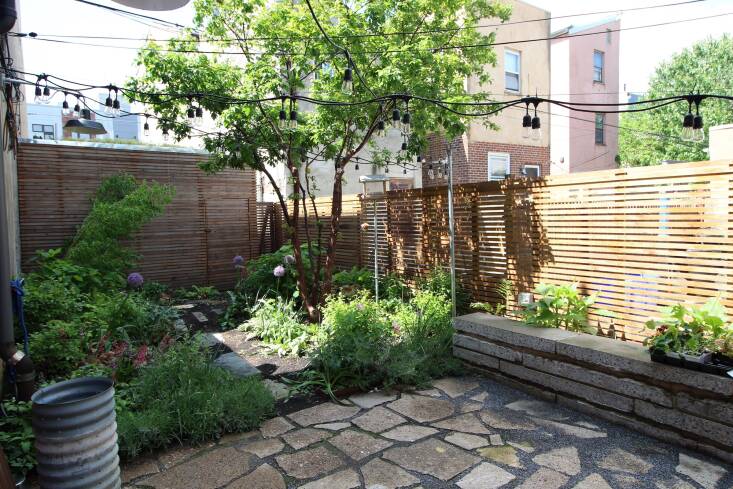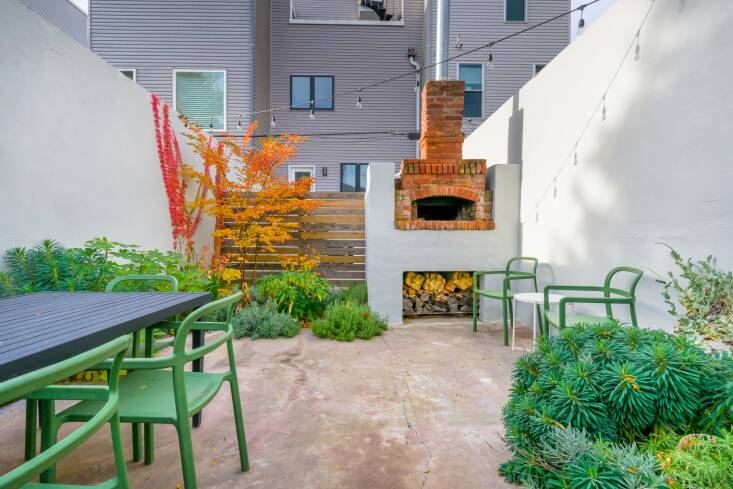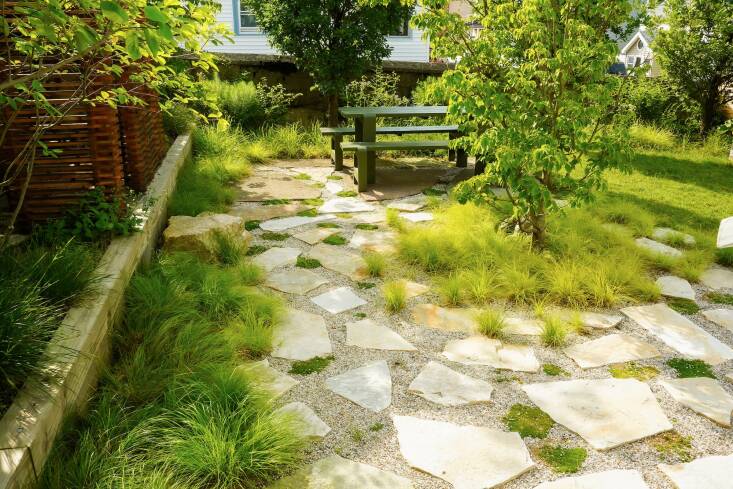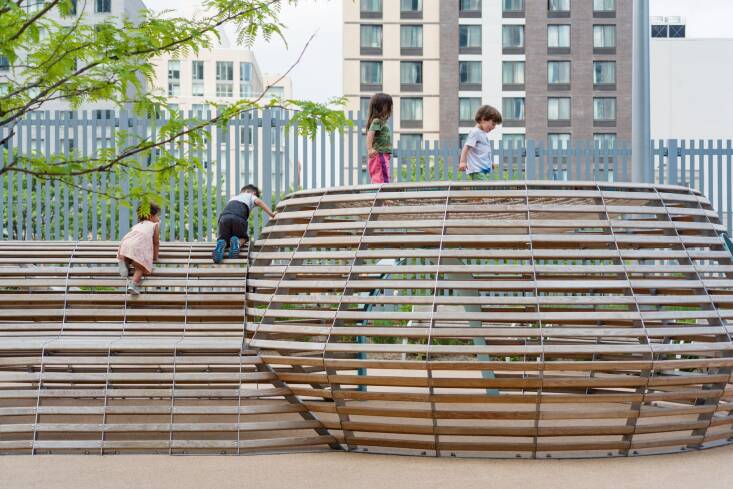As more garden and landscape designers aspire to create sustainable gardens, there’s one significant but often ignored aspect of sustainability they should pay attention to: hardscape materials. For most landscapes, the materials for the decks, patios, paths, and stairs will make up the vast majority of the project’s carbon footprint.
When people think of carbon footprint they often think of actions like driving a combustion engine car and flying on airplanes, but materials also possess an embodied (or upfront) carbon footprint. The “embodied” carbon is not, in fact, embodied in the material. Rather, it is an estimate of the emissions that come from making the material and shipping it. Unfortunately, some of the landscape industry’s favorite materials, including concrete and tropical hardwoods like ipe, have a high embodied carbon. (Taking in all stages of production, concrete is estimated to be responsible for 4 to 8 percent of the world’s CO2.)
“I don’t think clients are aware of the carbon footprint that concrete has,” says Sara Brunelle, co-founder of the landscape design firm Lu — La Studio, based in Cambridge, MA. “People are interested in pollinators and ecological properties, but they’re not really thinking about the material implications of their project.” However, homeowners and designers alike should consider the climate impacts of the materials they choose for their gardens.
We spoke to experts who are designing with low-carbon hardscape materials to ask them for their best advice when it comes to low-carbon hardscapes. Here’s what they said.
Less is more.
Above: More plants, less hardscaping in this backyard designed by Terremoto. Photograph by Caitlin Atkinson, from The Future of Gardening: A Plan From Terremoto.
Want to lower the carbon footprint of your landscape? Use less hardscape material. It’ll also be better for the environment overall. “Hardscape mostly prevents water from returning to the earth—and water returning to the earth is the first thing that has to happen in order to support or create life,” says David Godshall, co-founder of Terremotto, a landscape architecture studio with offices in northern and southern California. “So, the more hardscape a garden has, the more lifeless it is.” Of course, gardens need paths, patios and the like, but Godshall encourages garden designers to ask themselves what is the minimum amount of hardscape needed to make a space useful and enjoyable to everyone, including people who are differently abled.
Mine the site.
 Above: For this garden in the Fishtown neighborhood of Philadelphia, Apiary Studio made use of locally-sourced and recycled materials, including pieces of the old parking slab upcycled as pavers and a wall seat, which are softened by dense plantings. Photograph by Jaime Alvarez, courtesy of Apiary Studio.
Above: For this garden in the Fishtown neighborhood of Philadelphia, Apiary Studio made use of locally-sourced and recycled materials, including pieces of the old parking slab upcycled as pavers and a wall seat, which are softened by dense plantings. Photograph by Jaime Alvarez, courtesy of Apiary Studio.
Apiary Studio, a landscape architecture design-build firm in Philadelphia, has made a name for themselves upcycling hardscape materials in creative ways. They encourage gardeners and designers to consider what materials are already on the site. “Using your site as your main resource is the very best way to keep your carbon footprint low,” says co-founder Martha Keen/ She and her partner, Hans Hesselein, call this “mining the site.” (Godshall thinks of it as “closing the loop.”) In Apiary Studio’s hands, even pieces of an old concrete slab can be used to aesthetic effect. “The trick to using recycled materials is to make them look intentional and well crafted,” says Hesselein.
Retrofitting is better than re-doing.
 Above: In this Philadelphia backyard, Apiary Studio surgically removed portions of the concrete slab to create planting beds. Photograph by Jaime Alvarez, courtesy of Apiary Studio.
Above: In this Philadelphia backyard, Apiary Studio surgically removed portions of the concrete slab to create planting beds. Photograph by Jaime Alvarez, courtesy of Apiary Studio.
That said, often doing less is the most sustainable option. “To tear [concrete] out and replace it with new green paving is actually less green than just leaving it in place,” adds Hesselein. Instead, Apiary Studio will sometimes surgically cut out garden beds from a concrete slab and unearth the native soil beneath it, explains Keen.
Seek out salvaged stone.
 Above: “In excavating the pool, we ended up with a large quantity of rock that we then put to good use in building the site walls,” ays Godshall of this functional drystone wall that separates parking from the garden on the other side. Photograph by Caitlin Atkinson, from Garden Visit: ‘A Cute One in Ojai’ from Terremoto.
Above: “In excavating the pool, we ended up with a large quantity of rock that we then put to good use in building the site walls,” ays Godshall of this functional drystone wall that separates parking from the garden on the other side. Photograph by Caitlin Atkinson, from Garden Visit: ‘A Cute One in Ojai’ from Terremoto.
“Prioritize using salvaged stone material,” says Godshall, who notes the carbon footprint of salvaged stone is much lower than newly quarried stone because it’s already been extracted from the earth. “Whether it’s mining dry river beds for gravel or exhuming flagstone out of the earth, those are environmentally negative processes that require a lot of energy,” says Godshall. Brunelle and Smith like to scour the stone yard for scraps and odd pieces that might otherwise go to waste.
Shop local.
 Above: Lu — La Studio sourced salvaged stone slabs from a local stone yard for this project in Somerville, MA. Elsewhere in the same yard they used upcycled cobblestones. Photograph by Haley Dando, from Before & After: In Somerville, MA, Depaving (and Rewilding) a Parking Lot.
Above: Lu — La Studio sourced salvaged stone slabs from a local stone yard for this project in Somerville, MA. Elsewhere in the same yard they used upcycled cobblestones. Photograph by Haley Dando, from Before & After: In Somerville, MA, Depaving (and Rewilding) a Parking Lot.
When salvage is not an option, choose local stone. In general, distance is an easy metric to determine a material’s carbon footprint. “In the US we mostly move stuff around with trucks, which burn gas and create pollution,” explains Godshall. “So distance is a pretty simple and useful metric.” He adds that there is a visual benefit to sourcing local materials. “When you use materials that are from a more local place, the aesthetic of your project gets imbued with a regional quality or vernacular,” he says, noting it’s also better for your community. “When you source locally you create economic resiliency with people close to you.” For his part, Hesselein specifies blue stone when upcycled materials aren’t the right aesthetic for a project. “We use a lot of blue stone, which we feel good about because it is a beautiful stone acquired in New York and Pennsylvania, it’s not coming from very far away,” he says.
Minimize concrete.
 Above: The concrete patio (at left) was already there when Terremoto was tapped to rethink this backyard. Instead of getting rid of it, they surrounded it with lushness. Photograph courtesy of Terremoto, from Before &; After: From Desert to Redwood Forest, the Essence of California in One LA Garden.
Above: The concrete patio (at left) was already there when Terremoto was tapped to rethink this backyard. Instead of getting rid of it, they surrounded it with lushness. Photograph courtesy of Terremoto, from Before &; After: From Desert to Redwood Forest, the Essence of California in One LA Garden.
While concrete is a carbon-intensive material, it’s not going away any time soon: All the designers we spoke to still use concrete in some instances, for example, for an ADA-compliant path or a retaining wall. “When we do, we’re just really honest with ourselves about how we use that material and then keep it to the absolute minimum,” says Godshall. If Apiary needs to use new concrete they try to use permeable pavers “to permit stormwater infiltration underneath the patio,” says Hesselein. Brunelle and Smith note that concrete is often used underground and that their firm sets footings into gravel to avoid it. “Our custom climbing structures are set in a gravel base and they’re just as secure. It actually helps the wood’s longevity too, because then the gravel doesn’t retain moisture the same way that concrete does,” adds Smith.
Skip tropical woods.
 Above: Lu — La Studio used regionally-sourced Black Locust woo, sourced from and designed with Tri-Lox, for their NEST play structures. Photograph by PJ Rountree, courtesy of Lu — La Studio.
Above: Lu — La Studio used regionally-sourced Black Locust woo, sourced from and designed with Tri-Lox, for their NEST play structures. Photograph by PJ Rountree, courtesy of Lu — La Studio.
While wood generally stores carbon, manufacturing tropical hardwood decking, including ipe, is causing deforestation in rainforests, which are vital carbon sinks. These tropical woods also have a high carbon footprint associated with being transported across the globe. Brunelle says that avoiding tropical hardwoods was part of the inspiration to start her own firm. “We just should not be using tropical hardwoods, ” she says. Brunelle and business partner Katie Smith suspect that designers are still sourcing ipe and other tropical woods because it’s what they learned early in their careers. “We need a generational change towards materials–just because we’ve always used it doesn’t mean we should,” says Brunelle. “We have wonderful hardwoods on the East Coast: rubia, eastern white cedar—even tulip trees.” Note: While thermally modified and pressure-treated soft woods can have lower carbon impacts than tropical hardwoods, they carry higher levels of chemicals and emissions from their manufacturing.
Rethink driveways.
 Above: Landscape architect David Maynes found a low-impact way to reimagine a client’s asphalt driveway: He cut away sections of the asphalt creating “pavers” that lead to the house designed by Elliott Architects. Photograph by Bruce Richter.
Above: Landscape architect David Maynes found a low-impact way to reimagine a client’s asphalt driveway: He cut away sections of the asphalt creating “pavers” that lead to the house designed by Elliott Architects. Photograph by Bruce Richter.
Driveways can account for a huge portion of the carbon footprint of a project, so try to minimize their size and/or consider a permeable or ribbon design. Asphalt is considered less carbon-intensive than concrete because it incorporates bitumen, a waste product, and gravel has even less embodied carbon than asphalt but unfortunately won’t work on a steep slope. David Maynes, a landscape architect based in Maine, came up with a particularly creative solution for his client’s asphalt driveway. Maynes drew oversized pavers onto the existing driveway and had his contractor saw away the negative spaces. The result is more permeable soil and a more eye-pleasing look.
Don’t send materials to the landfill.
 Above: After depaving the yard adjacent to their Los Angeles office, Terremoto has begun using it as a material supply yard full of salvaged and upcycled materials. Photograph courtesy of Terremoto.
Above: After depaving the yard adjacent to their Los Angeles office, Terremoto has begun using it as a material supply yard full of salvaged and upcycled materials. Photograph courtesy of Terremoto.
“We always try to get the right materials, but some things happen where we might end up with too much,” says Smith. Rather than send the excess to the landfill, try to find someone who can use it, posting to a site like Facebook Marketplace or a Buy Nothing Group. Terremoto has gone further, using the garden space at their office to store extra materials for future projects.
For more on how to be more sustainable in your outdoor space, check out our new book, Gardenista: The Low-Impact Garden—and these posts as well:



